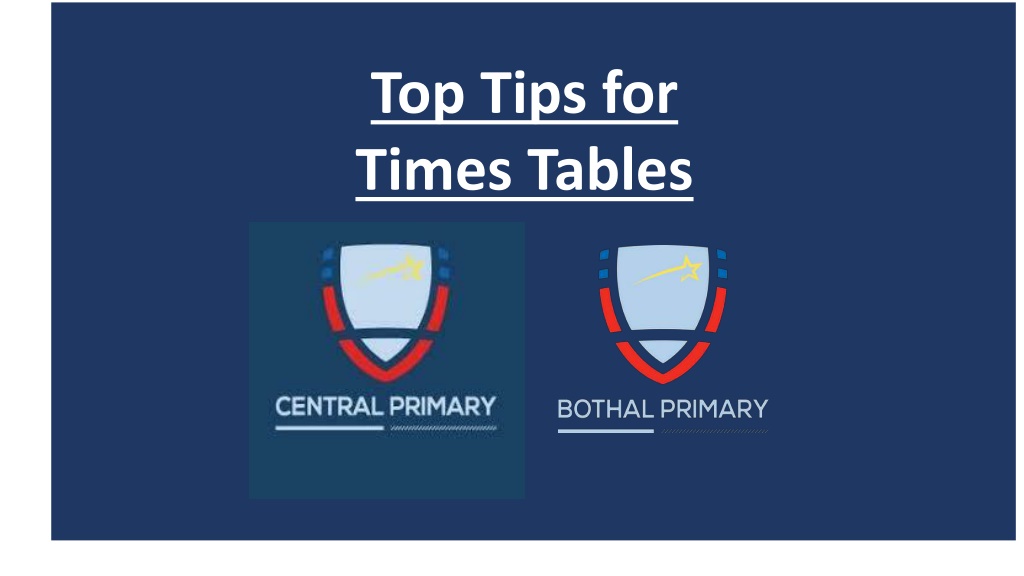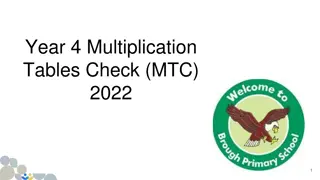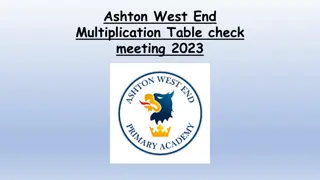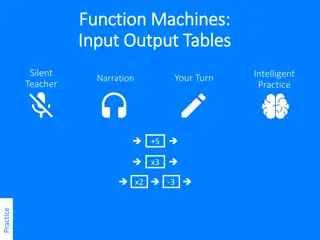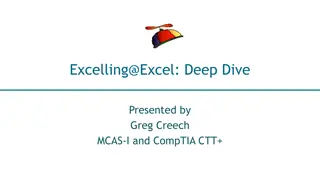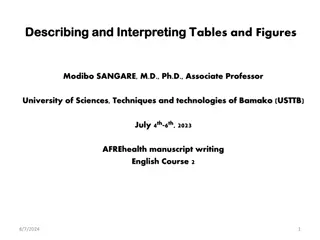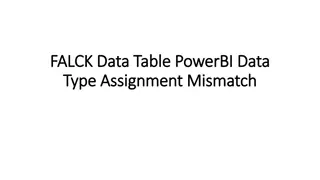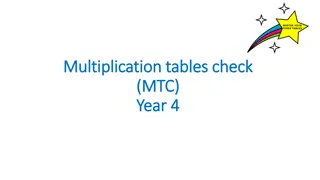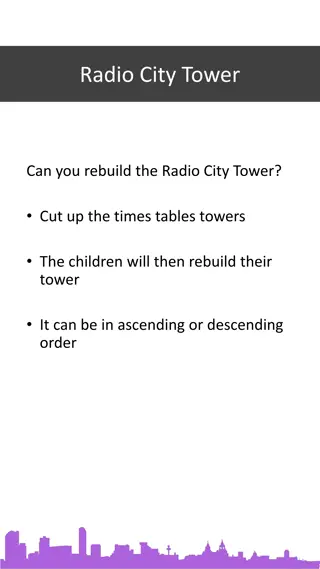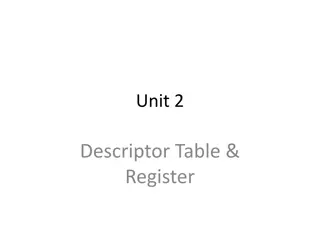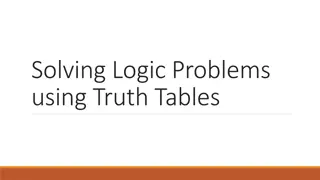Essential Tips for Learning Times Tables
Learning times tables is crucial for children's math education. It is important for quick mental math and understanding of fractions and larger numbers. Collaboration between schools, parents, and children is key for effective learning. Check the progression of times tables knowledge by the end of each academic year. Get insights on the new National Times Table Check for Year 4 pupils.
Download Presentation

Please find below an Image/Link to download the presentation.
The content on the website is provided AS IS for your information and personal use only. It may not be sold, licensed, or shared on other websites without obtaining consent from the author.If you encounter any issues during the download, it is possible that the publisher has removed the file from their server.
You are allowed to download the files provided on this website for personal or commercial use, subject to the condition that they are used lawfully. All files are the property of their respective owners.
The content on the website is provided AS IS for your information and personal use only. It may not be sold, licensed, or shared on other websites without obtaining consent from the author.
E N D
Presentation Transcript
Top Tips for Times Tables
We hope this booklet is helpful. Please feedback your thoughts to us on our FB site, or any great ideas you d like to share about learning times tables. Knowing times tables facts is crucially important to your child s progression in their mathematics education. Without a thorough understanding of multiplication and division facts, children frequently get lost when it comes to do anything with fractions and any multiplication or division with larger numbers. Many mental maths activities and tests require a quick recall of multiplication and division facts. Children who are secure in their times tables knowledge are able to get to grips with trickier tasks straight away and are far more successful. It is worth explaining what we mean by knowing times tables. A child who knows their times tables will be able to recall any of the multiples of a times table out of order within 3 seconds, as well as knowing the corresponding division facts i.e. 4 x 6 = 24 as well as 24 6 = 4.
Learning multiplication facts and tables are most effective when there is collaboration with school, parents and children. In school we regularly spend time learning times tables, but a child will be much more successful if they practise outside school independently and alongside parents. Independently With parents With teachers
Below are the times tables your child should know as a minimum by the end of each academic year. Reception: Year 1 By the end of Year 2 By the end of Year 3 By the end of Year 4 By the end of Year 5 By the end of Year 6 When counting objects, children should be able to group in twos, fives and tens and record the total. Record sequences of twos, fives and tens (e.g. 2, 4 6, 8 etc.) and identify any missing multiples. Know off by heart the doubles and halves of numbers to 12. Draw and use arrays to solve multiplication problems. 2, 5, 10 including division facts. 2, 3, 4, 5, 8, 10 including division facts. All times tables up to 12 x 12 with division facts. As Year 4 and related questions e.g. 1/9 of 63 is 7. Knowledge of prime numbers to 19. As Year 5 and a knowledge of prime numbers below 100. Identify common factors and multiples.
New National Times Table Check for pupils in Y4. From the 2019/20 academic year onwards, all state-funded schools in England will be required to administer an online multiplication tables check (MTC) to year 4 pupils. The National Curriculum says that pupils should be taught to recall the multiplication tables up to and including 12 12 by the end of year 4. The purpose of the Multiplication Tables Check is to determine whether pupils can recall their times tables fluently, which is essential for future success in mathematics. It will help schools to identify pupils who have not yet mastered their times tables, so that additional support can be provided. Schools will have a 3-week window to administer the Multiplication Tables Check. Teachers will have the flexibility to administer the check to individual pupils, small groups or a whole class at the same time. The test will be online and will last for 5 minutes. In this time they will have to answer 25 times table questions. Children will be need to be able to answer randomly generated times tables questions using a key pad on a computer every 6 seconds or so. Further information can be found at: https://www.gov.uk/guidance/multiplication-tables-check-development- process#guidance-and-videos
Times Tables Vocabulary Here are some words that may be used whilst learning and applying multiplication and division. multiply divide prime product once, twice, three times lots of repeated addition times factors array: row, column double repeated subtraction multiple sets of Remainder halve.
Times Table Dictionary Factor One number is a factor of another if it divides or goes into it exactly (without any left over, a remainder). E.g. 6 is a factor of 30 because it goes into it 5 times, but is not a factor of 33 because after dividing there is a remainder of 3. Groups of/ lots of/ sets of 3 groups of 5 are 15, 3 lots of 5 are 15, 3 sets of 5 are 15 (3 x 5 = 15). Multiple - These are the numbers that you find in a times table. E.g. 20 is a multiple of 5, 4, 2 and 10 because it is found in all of those times tables. The multiples of 5 are 5, 10, 15, 20 etc. Product - A product is the answer you get when you multiply two or more numbers together. E.g. the product of 3 and 4 is 12 (3 x 4 = 12). Prime A prime number will only divide equally between 1 and itself e.g. 7, 11. The first ten prime numbers are: 2,3,5,7,11,13,17,19,23,29. Array As shown: an array is a visual representation of multiplication. Shown are 3 rows of 5 with 15 in total.
What is Times Tables Rock Stars? At Central Primary School we use Times Tables Rock Stars as a carefully sequenced programme of times tables practice. This format has very successfully boosted times tables recall speed for hundreds of thousands of pupils over the last 8 years in over 14,000 schools - both primary and secondary worldwide. Your child will be able to design their own Avatar and then can compete with friends, classmates, other year groups and other schools to gain points and make their way up the leader boards to Rock Hero.
Learning Times Tables The Key to learning times tables is frequent repetition, regular revision. 5 to 10 minutes every day is better than an hour a week. A poster on the wall that is not used is simply wall paper. Here are some ideas to help your child memorise their multiplication and division facts. 1. Chanting When beginning to learn a times table this is key. Repeatedly reading a times table out aloud will help your child become familiar with the multiples for that times table. Try and keep a rhythm, changing vocabulary regularly (two times three is six, two threes are six, two lots of three are six etc.) Clapping or marching may help with keeping the rhythm going. (See school website for times tables lists). 2. Flash Cards Make a set of cards for the times table being learnt by putting a question on one side of the card (6 x 5 =) and the answer on the reverse (30). Go through the cards reading the question and then turning over to see the answer. Try and say the answer before you turn over. When familiar with the multiplication table, the cards can then be shuffled and used in a random order. 3. Testing and Timing Make this fun. When your child has become more confident at learning a particular times table, ask them questions on it and see how many they can get correct in a particular time. Alternatively write some questions out of order and get them to time how long it takes to complete the questions. Can they beat their time and score? (see http://www.online-stopwatch.com) for a variety of different timers.
4. Using a multiplication Square A multiplication square is particularly useful for establishing the link between multiplication and division facts but can also be used instead of a times table list. When children are more confident with their times table knowledge, a blank multiplication square can be filled in. Time your child to complete their square, or see how many multiples they can complete in a set time. Can they beat their score and time? (see school website for complete and blank multiplication squares). 5. Times Tables Games Bingo is a great way of learning times tables as a family. Write 6 multiples from a particular times table down in a grid and the caller reads out questions from the same multiplication table. Rolling dice and multiplying the numbers together is a good way to compete with each other to get the correct answer first. Two dice can be rolled at once to create all questions up to 12 x 12. A similar game can be created with playing cards where two cards are chosen and their values multiplied together. The Jack, Queen and King need to be 11, 12 and 0. To help with division, each player chooses and writes down five of the following numbers: 5, 6, 8, 9, 12, 15, 20, 30, 40 and 50. Take it in turns to roll a dice and if the number you roll is a factor of one of your numbers, cross it out. E.g. if a 4 is rolled it goes into 8 so cross out 8. If 1 is rolled, you miss a go; if 6 is rolled you get an extra turn. The winner crosses all of their numbers out first. These are just a few games. If you create any of your own or find some really good ones, please let us know!
Learning Times Tables 6. Online Resources There are many free multiplication and division games available online. Just use the search engine to uncover them all. Here are a few places to get you started: https://ttrockstars.com/ www.multiplication.com www.coolmath-games.com http://www.oswego.org/ocsd-web/games/Mathmagician/mathsmulti.html http://www.transum.org/Tables/Times_Tables.asp www.tablestest.com www.mathletics.co.uk Many apps also exist for smart phones and tablets. Many of these are free to download. Search in the App store or on Google Play. Ibooks can also be helpful such as Carol Vorderman Maths Made Easy Times Tables. Songs can be accessed on Mathletics (Times Tables Toons) or can be downloaded at a cost. For example Times Tables Challenge by Kidzone, available through Amazon mp3. Youtube have many popular songs to help. These online resources are good but are usually not enough in themselves for learning multiplication tables off by heart. They are best suited for consolidating times table knowledge and for increasing the speed of recall. 7. Quick Questions Anywhere! A few questions here and there are much better than hundreds in one go: on the way to school in advert breaks whilst getting dressed a few before bed going up and down stairs
Top Times Table Hints It may seem a daunting task to learn so many multiplication facts, but because of the commutative property of multiplication, there are fewer facts than you may think. For example, 3 x 4 and 4 x 3 give the same answer so you need to only learn this once. Zero Times Table Anything multiplied by zero will always equal zero. Multiplication is repeated addition so 3 x 0 is 0 + 0 + 0, which equals 0. One Times table: Any number multiplied by one is itself. Two Times Table: Any number multiplied by two is double the number. 7 x 2 =14 7 + 7 = 14 double 7 is 14 Three Times Table: Digits within this times table add up to multiples of 3. For example: 3, 6, 9, 12 (1+2=3), 15 (1+5=6), 18 (1+8=9) 21 (2+1=3), 24 (2+4=6) etc. The numbers also follow the pattern of: odd, even, odd, even (3,6,9,12). Four Times Table: The four times table is double the two times table. 4 x 2 = 8, 4 x 4 = 16, 16 is double 8. Alternatively the fours can be thought of as double double. So double 3 (6) and double again (12) is the same as 3 x 4 = 12.
Five Times Table: All multiples of 5 end in five or zero. For even numbers (e.g. 8 x 5) you can halve the number (4) and then put a zero after it (40). For odd numbers (e.g. 7 x 5) you can subtract one from the number (6), halve it (3) and then put a 5 after it (35). Any odd number times 5 ends in a 5. Any even number times 5 ends in 0. Six Times Table: The six times table is double the three times table. So 5 x 3 = 15, 5 x 6 = 30, 30 is double 15. Seven Times Table: Combine the 5 and the 2 times table: 7 x 4 = 28 or (5x4) + (2x4) = 28 Eight Times Table: The eight times table is double the four times table. So 7 x 4 = 28, 7 x 8 = 56, 56 is double 28. The units in the multiples of eight also go down in twos. 8, 16, 24, 32, 40, 48, 56, 64, 72, 80 (8, 6, 4, 2, 0, 8, 6, 4, 2, 0).
Nine Times Tables Fingers can be used to work out the nine times table up to 10 x 9. The first finger is put down for 1 x 9 and the remaining fingers show 9 units (1 x 9 =9). Then the second finer is put down for 2 x 9 and the remaining fingers show 1 ten (to the left) and 8 units (to the right) which equals 18, and so on. For example: The digits found in the multiples of nine when added together also equal nine. For example: 9 = 9, 18 (1 + 8) = 9, 27 (2 + 7) = 9, 36 (3 + 6) = 9, 45 (4 + 5) = 9 etc. See the pattern shown: .
Ten Times Table: All the digits in the ten times table end in zero. Eleven Times Table: Most of the multiples in the eleven times table are recalled by putting two of the number side by side. 7 x 11 = 77, 8 x 11 =88. Twelve Times Table: The units in the twelve times table go up in twos. 12, 24, 36, 48, 60, 72, 84, 96, 108, 120, 132, 144 (2, 4, 6, 8, 0, 2, 4, 6, 8, 0). The multiples of 12 are also the multiples of 10 and the multiples of 2 combined
Odd and Even Numbers E = even O = odd The following rules always apply: E x E = E E x O = E O x E = E O x O = O 2 x 6 = 12 4 x 5 = 20 9 x 2 = 18 7 x 3 = 21 Therefore, the only time you get an odd answer is when two odd numbers are multiplied together. 12 x 12 Multiplication Grid Notice the diagonally shaded numbers. These are square numbers. The answer to a whole number multiplied by itself is a square number. 1 x 1 = 1 2 x 2 = 4 3 x 3 = 9 4 x 4 = 16 5 x 5 = 25 6 x 6 = 36 7 x 7 = 49 8 x 8 = 64 9 x 9 = 81 10 x 10 = 100 11 x 11 = 121 12 x 12 = 144
